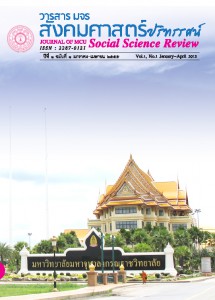ผลกระทบของสภาพแวดล้อมภายนอกองค์การด้านเศรษฐกิจ และพลังการแข่งขันใน อุตสาหกรรม กับสภาพแวดล้อมภายในด้านประโยชน์เกื้อกูล และความปลอดภัยที่มีผลต่อ การปฏิบัติศาสนกิจของพระภิกษุสามเณร ในจังหวัดชายแดนภาคใต้
คำสำคัญ:
การปฏิบัติศานกิจ; ความปลอดภัย; ผลกระทบ; พลังการแข่งขันในอุตสาหกรรม; สภาพ แวดล้อมภายนอกองค์กรด้านเศรษฐกิจ; สภาพแวดล้อมภายในด้านประโยชน์เกื้อกูล.บทคัดย่อ
การศึกษาเรื่องนี้ มีวัตถุประสงค์เพื่อศึกษาปัจจัยด้านเศรษฐกิจ พลังการแข่งขันในอุตสาหกรรม ความ ต้องการประโยชน์เกื้อกูลของพระภิกษุสามเณร และความปลอดภัยที่มีผลกระทบต่อการปฏิบัติศาสนกิจของ พระภิกษุสามเณรในจังหวัดชายแดนภาคใต้ โดยมีประชากรคือ พระภิกษุสามเณรที่ปฏิบัติศาสนกิจ ใน จังหวัดปัตตานี ยะลาและนราธิวาส ซึ่งมีอยู่ทั้งสิ้น ๗๒๐ รูป โดยตัวแปรต้นคือปัจจัยทางกายภาพของศาสน สถาน สภาพแวดล้อมภายนอกด้านเศรษฐกิจและพลังทางการแข่งขัน สภาพแวดล้อมภายในด้านประโยชน์ เกื้อกูลและความปลอดภัย ตัวแปรตามคือ ความสามารถในการปฏิบัติศาสนกิจ โดยใช้แบบสอบถามและ แบบสัมภาษณ์เป็นเครื่องมือในการเก็บรวบรวมข้อมูล ใช้วิธีการสุ่มตัวอย่างตามสะดวก ได้กลุ่มตัวอย่างรวม ทั้งสิ้น ๒๕๙ รูป ผลการศึกษา พบว่า กลุ่มตัวอย่างส่วนใหญ่มีอายุระหว่าง ๒๐-๓๐ ปี จำนวนพรรษา ๖-๑๐ พรรษา
วุฒิทางธรรมเปรียญธรรม ๑-๓ ประโยค วุฒิทางโลกส่วนใหญ่อยู่ในระดับปริญญาตรี วัดส่วนใหญ่มีขนาด เล็ก มีพระสงฆ์จำพรรษาน้อยกว่า ๑๐ รูป ระยะทางจากอำเภอถึงตัววัด ๐-๕ กิโลเมตร ส่วนใหญ่สามารถ รับกิจนิมนต์นอกวัดได้เดือนละ ๑-๑๐ ครั้ง สามารถปฏิบัติศาสนกิจที่วัดได้ทุกวันสำคัญ สภาพเศรษฐกิจ มีผลกระทบทำให้คนมาวัดลดลง ผู้ตอบมีความเห็นด้วยระดับ “มาก” ต่อประเด็นความรุนแรงของ สถานการณ์มีผลกระทบต่อการปฏิบัติศาสนกิจเล็กน้อย แต่เห็นด้วย “น้อย” ต่อประเด็นการเปลี่ยนศาสนา กับการที่รัฐบาลช่วยเหลือเหมาะสม และมีความเห็นเกี่ยวกับควรจัดสวัสดิการต่างๆ ในระดับปานกลาง แต่คิดว่าได้รับปัจจัยสี่พอเพียงแล้ว คำถามปลายเปิดยังไม่มั่นใจในความปลอดภัย ต้องการรถรับส่ง งบพัฒนาวัดและสนับสนุนกิจกรรม การสัมภาษณ์พระสังฆาธิการที่ดูแลจังหวัดทั้ง ๓ พบว่า อยากให้ดูแลสวัสดิการให้มากกว่านี้ โดยเฉพาะด้านสุขภาพ การศึกษา ความปลอดภัยในการไปเผยแผ่ ความทรุดโทรมของวัด ชาวพุทธมีจิตใจเข็มแข็ง รักสงบ แต่รัฐบาลช่วยเหลือน้อยไป ผู้วิจัยมีข้อเสนอแนะว่าควรสร้างเครือข่ายมหภาคช่วยเหลือชาวพุทธและใช้คณะกรรมการร่วมพระฆราวาสจัดสวัสดิการ รัฐบาลต้องบูรณาการงบให้ได้ประโยชน์ทั้งประกันความปลอดภัยทั้งในและนอกวัดเน้นการเผยแผ่เชิงรุก
เอกสารอ้างอิง
ชัยยุทธ นิโนกุล. ทฤษฎีและการจัดรูปองค์กร. กรุงเทพมหานคร : บริษัทสุขุมและบุตร, ๒๕๔๖. .การจัดการเชิงกลยุทธ์ หน่วยที่ ๒. กรุงเทพมหานคร : มหาวิทยาลัยสุโขทัยธรรมาธิราช, ๒๕๔๕.
ชำนาญ ปิยวนิชพงษ์. กรอบแนวความคิดสำหรับการจัดการทรัพยากรมนุษย์. กรุงเทพมหานคร : ซีเอ็ดยู เคชั่น, ๒๕๔๙.
พระราชรัตนโมลี. “โฉมหน้าประวัติศาสตรสากล”, นิตยสารพุทธจักร. ปีที่ ๕๙ ฉบับที่, ๖ มิถุนายน ๒๕๔๘.
สะอาด จันทร์ดี. กะเทาะเปลือกใต้ใครบงการ. กรุงเทพมหานคร : สหธรรมมิก, ๒๕๕๐.
Dessler, Gary. A framework for human resource management. 5 thed. Upper Saddle River, : Pearson/Prentice Hall, 2009.
Froyen, Richard T. and Low, Linda. Macroeconomics : an Asian perspective. Singapore : Prentice Hall, 2001.
Froyen, Richard T. Macroeconomics : theories and policies. 7th ed. Upper Saddle River. NJ. : Prentice Hall, 2002.
Jackson, susan E.; Schaler, Randall. S.; and Wener, Steve. Managing Human Resources. 10th ed. Mason : South-Western Cengage Learning, 2009.
Noe, Raymond A; Hollenbeck, John R; Gerhart, Barry; and Wright, Patrick M. Human
Resource Management : Gaining a Competitive Advantage. 6thed. Mcgraw-Hill Irwin. 2008.
Michael E ,Porter . Competitive Strategy : Techniques for Analyzing Industries and Competitors. New York : The Free Press, 1980.
Wheelen, Thomas L; and Hunger, J. David. Strategic Management and Business Policy. 11thed. Upper Saddle River, New Jersey : Pearson Practice Hall,2008.
Taro, Yamane. Statistics : an introductory analysis, 3rd ed. New York : Harper &Row, 1973.
ดาวน์โหลด
เผยแพร่แล้ว
รูปแบบการอ้างอิง
ฉบับ
ประเภทบทความ
สัญญาอนุญาต
ลิขสิทธิ์ (c) 2018 วารสาร มจร สังคมศาสตร์ปริทรรศน์

อนุญาตภายใต้เงื่อนไข Creative Commons Attribution-NonCommercial-NoDerivatives 4.0 International License.
เพื่อให้เป็นไปตามกฎหมายลิขสิทธิ์ ผู้นิพนธ์ทุกท่านต้องลงลายมือชื่อในแบบฟอร์มใบมอบลิขสิทธิ์บทความให้แก่วารสารฯ พร้อมกับบทความต้นฉบับที่ได้แก้ไขครั้งสุดท้าย นอกจากนี้ ผู้นิพนธ์ทุกท่านต้องยืนยันว่าบทความต้นฉบับที่ส่งมาตีพิมพ์นั้น ได้ส่งมาตีพิมพ์เฉพาะในวารสาร มจร สังคมศาสตร์ปริทรรศน์ เพียงแห่งเดียวเท่านั้น หากมีการใช้ภาพหรือตารางหรือเนื้อหาอื่นๆ ของผู้นิพนธ์อื่นที่ปรากฏในสิ่งตีพิมพ์อื่นมาแล้ว ผู้นิพนธ์ต้องขออนุญาตเจ้าของลิขสิทธิ์ก่อน พร้อมทั้งแสดงหนังสือที่ได้รับการยินยอมต่อบรรณาธิการ ก่อนที่บทความจะได้รับการตีพิมพ์ หากไม่เป็นไปตามข้อกำหนดเบื้องต้น ทางวารสารจะถอดบทความของท่านออกโดยไม่มีข้อยกเว้นใดๆ ทั้งสิ้น





